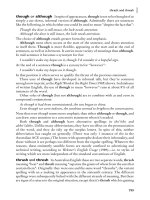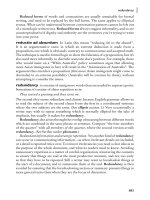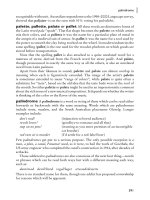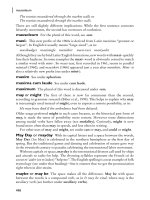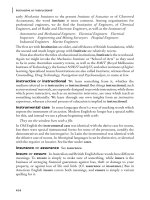Perfect prepositions a real life guide to using english prepositions
Bạn đang xem bản rút gọn của tài liệu. Xem và tải ngay bản đầy đủ của tài liệu tại đây (32.19 MB, 288 trang )
Galina Kimber
A REAL LIFE GUIDE
TO USING ENGLISH PREPOSITIONS
Perfect Prepositions
Perfect Prepositions
A Real Life Guide to Using
English Prepositions
Galina Kimber
iUniverse, Inc.
New York Lincoln Shanghai
Perfect Prepositions
A Real Life Guide to Using English Prepositions
Copyright © 2006 by Galina Kimber
All rights reserved. No part of this book may be used or reproduced by any
means, graphic, electronic, or mechanical, including photocopying, recording,
taping or by any information storage retrieval system without the written
permission of the publisher except in the case of brief quotations embodied in critica
articles and reviews.
iUniverse books may be ordered through booksellers or by contacting:
i Universe
2021 Pine Lake Road, Suite 100
Lincoln, NE 68512
www. i uni verse, co m
1 -800-Authors (1 -800-288-4677)
ISBN-13: 978-0-595-37577-6 (pbk)
ISBN-13: 978-0-595-82256-0 (cloth)
ISBN-13: 978-0-595-81971-3 (ebk)
ISBN-10: 0-595-37577-4 (pbk)
ISBN-10: 0-595-82256-8 (cloth)
ISBN-10: 0-595-81971-0 (ebk)
Printed in the United States of America
31143085911715
428
Kimber
Kimber, Galina.
Perfect prepositions : a
real life guide to using
English prepositions
ACKNO WLEDG EMENTS
I wish to express my acknowledgement to Dr. J. Franke and Dr. V. Mylnikov who
read through the manuscript and made valuable remarks and suggestions as to
the contents and the structure of this book. I wish to thank my husband, John
Evans Kimber, for reading the draft and helping me identify and address some of
the shortcomings, even if I did not always accept all of advice that came my way.
v
1
THE STRUCTURE OF THE BOOK
The book consists of several sections. The introductory part explains the reasons
for writing this book and for whom it is designed. Then it lists objective and subjective difficulties the author met with while preparing it and principles of organizing the contents as well as for choosing illustrative material. The terms used in
the book are explained in the section ‘The Structure of the Definition of the
Category.’ The practical part of the book contains the lists of the categories for 99
prepositions and their meanings as well as the examples illustrating them. Our
research showed that the most frequently used prepositions in Modern English
are the prepositions on, at, by, for, in, of, and with. An Appendix is attached at the
end of the last section.
Vll
V
CONTENTS
Section with Prepositions and Examples
ACKNOWLEDGEMENTS
v
THE STRUCTURE OF THE BOOK
vii
INTRODUCTION
xiii
ABOARD/ON BOARD
1
ABOUT
1
ABOVE
8
ACCORDING TO
10
ON ACCOUNT OF
10
ACROSS
11
IN ADDITION TO
13
AFTER
13
AGAINST
16
AHEAD OF
19
ALONG
19
ALONGSIDE
20
AMID (ST)
21
AMONG (ST)
21
APART FROM
22
AROUND
22
AS
23
AS FOR/TO
23
IX
x
Perfect Prepositions
ASIDE FROM
26
AS OF
26
AT
26
ATOP
41
IN BACK OF
41
BECAUSE OF
41
BEFORE
42
IN/ON BEHALF OF
43
BEHIND
43
BELOW
45
BENEATH
46
BESIDE
48
BESIDES
49
BETWEEN
49
BEYOND
51
BUT
53
BUT FOR
53
BY
53
IN CASE OF
60
CLOSE TO
60
CONCERNING
60
CONSIDERING
61
CONTRARY TO
61
DESPITE
61
DOWN
62
DUE (TO)
62
DURING
63
EXCEPT
64
FACING
64
Galina Kimber
xi
IN FAVOR OF
64
FOR
65
FROM
76
IN FRONT OF
81
IN
81
INSIDE (OF)
95
INSTEAD OF
96
INTO
96
LESS
104
(UN) LIKE
104
NEAR
106
NEXT TO
106
NOTWITHSTANDING
107
OF
107
OFF
118
ON
124
ON TOP OF
155
ONTO
156
OPPOSITE
157
OUT
157
OUT OF
158
OUTSIDE (OF)
164
OVER
165
OWING TO
175
PAST
176
PER
178
IN PLACE OF
178
PRIOR TO
179
RE
179
xii
Perfect Prepositions
REGARDLESS OF
179
RESPECTING
180
ROUND
180
SAVE
181
SINCE
181
IN SPITE OF
181
THAN
182
THANKS TO
182
THROUGH
182
THROUGHOUT
188
TILL
189
TO
189
TOWARD(s)
209
UNDER
212
UNDERNEATH
215
UNLIKE
216
UNTIL
216
UP
217
UPON
219
VERSUS
222
VIA
222
IN VIEW OF
223
BY WAY OF
223
WITH
224
WITHIN
237
WITHOUT
239
WORTH
241
APPENDIX
243
INTRODUCTION
REASONS FOR WRITING THIS BOOK
There are about 100 prepositions in the Modern English language. Their primary function is to signal or emphasize the syntactic and semantic role of
notional (content) words in a phrase or a sentence. They have their own, though
very abstract, meanings too. Like any other functional (relational) elements in a
language, prepositions are high frequency words. However they pose more communication problems for learners of English as well as for native speakers than
any other part of speech, though they are short words that seem to never change
in form.
To begin with, in oral speech, being used in most of the cases in an unstressed
syllable, the prepositions are pronounced fast and not very clearly. As a result of
that, they are often barely distinguishable to the listener. Or take as an example
the versions of some prepositions, such as: amid and amidst (variant of amid);
among and amongst (variant of among); beside and besides (besides being an
adverb). In addition, in written speech, there are circumstances when prepositions cause difficulties due to a variety of factors that I will mention later in the
research. For instance, the following commonly used sentences often cause certain difficulties with non-native English speakers:
Interact with people at school, (or in school?)
He graduated high school in 1996. (or from high school?)
Children would starve in the streets, (or on the streets?)
Or, compare, for instance, the sentences with two different prepositions connected with one and the same verb:
He never wrote of it to anyone.
(Meaning, it didn’t occur to him to write of it).
xiii
XIV
Perfect Prepositions
He wrote nothing about it.
(Meaning, he never mentioned it).
It takes learners time and sometimes a lot of practicing to gain ‘the feeling of
what versions of the above sentences are appropriate in a particular situation. This
is one of the reasons I see a reference book on prepositions is needed.
Another reason for writing this book pertains to the fact that living languages,
and primarily the meanings of the words, constantly evolve over time. It’s a wellknown fact that dictionaries get outdated the moment they are published. So to
reflect these changes, reference books describing various special phenomena in
any given language, like this one, need to be updated or compiled anew on a regular basis.
5
That is why this book is intended to provide the user with general information
about prepositions, on the one hand, and, on the other, with more specific information and ideas about the meaning and usage of one of the most dynamic parts
of the speech in nearly any language—prepositions as they are used today.
FOR WHOM THE BOOK IS INTENDED
As this reference book deals with the most commonly used prepositions and
presents some basic rules of usage for these functional words, it may be helpful
primarily for students of English, at any level of their studies, as well as the teachers, as a source of examples for practicing with the students. Also, researchers of
language may find some new ideas, regarding the meanings of the words that I
tried to present in the unified form of general logical or semantic categories such
as the category ‘moving in some direction. Besides, I think that the materials presented in this book may be handy as a reference source in compiling dictionaries,
grammar books and some textbooks.
I should mention here, however, that no book, this book including, can cover
all possible cases of occurrence for a word, both in the oral and written types of
speech, because any living language is an open, constantly changing system.
Speech is often spontaneous so that an established traditional meaning of a word
may be slightly different in a particular sentence. This book focuses exclusively on
the analysis of only one part of speech and provides several examples for each
usage of a preposition. That’s why it has the capacity to offer more variants or
nuances of a meaning for each preposition than, e.g., an entry in a dictionary for
this preposition.
I hope that this book will assist the reader in using the language with more
precision, color and vitality. There is no doubt that this book is only one effort on
Galina Kimber
xv
the part of the linguists in the continuous process of studying the semantics of
form words. A further research on the subject is necessary and welcome to make
sure the readers get a regular update on the usage of prepositions in Modern
English.
xvi
Perfect
Prepositions
WAYS AND DIFFICULTIES IN DEFINING THE MEANING OF A
PREPOSITION
In this book we define prepositions to be a part of speech with rather abstract
semantics serving to show the relationships between notional tin its of speech
(words, phrases, clauses) that usually have full lexical meanings in word combinations or in sentences. A preposition expresses a relationship of the meanings
between at least two parts in a sentence, and by that, between two or more ideas,
or semantic categories.
Under category we understand an idea or concept, sense, essence, a term, a
basic logical type of philosophical conception, a class or division in a system of
classification, or a grouping.
Meaning is an interpreted goal or intent, an indication, a message. Meaning is
an interpretation of something that is mostly conveyed by language or implied as
an inner significance. Meanings can be looked at as linguistic embodiments of the
essence of a category or rather of a group of categories in speech. Meanings can be
denotational or connotational. Prepositions have primarily abstract denotational
meanings.
A preposition is usually presented by a single word {in, at, by), sometimes by a
phrase functioning as a single word {according to, in view of). Not all linguists
include such units as well as the words but, following, like, than in the class of the
prepositions. 1 hat is why it is not easy to delineate the exact amount of prepositions as a class or a part of speech.
I hough we gave a definition of prepositions as a part of speech or class above,
their individual meanings are not easy to define in every day real life occurrences
as they do not always function according to a clear set of rules. In some dictionaries, the meaning of a preposition may be defined through the meaning of
another preposition, a synonym, e.g. on means ‘above and supported by as in the
sentence: 1 he book is on the table.’ When two or more prepositions have the
same meaning, when they are synonyms, they are sometimes interchangeable in
their usage, which means they contain the same category in their meanings:
He was pleased by/with the answer.
However, not all prepositions have synonyms or antonyms which they may
be defined by. That is why this method to find out the meaning of a preposition
does not work in all the cases. I applied the inductive method in this research to
find out the meaning of a preposition in a sentence at the syntactic and semantic levels, which means I tried to derive a meaning of a preposition primarily
from the examples I gathered, not from reference books. Syntactically and
Galina Kimber
xvi 1
semantically, all prepositions enter into relationships with all of the words in a
sentence, but have more close, primarily semantic links, with some of them,
usually a noun, a verb, or an adjective, in a phrase as a part of the sentence. For
example, in the following sentence, the verb lying is a governing, or a head word,
in the phrase lying on the carpet.
My cat is lying on the carpet.
The nominal phrase the carpet that follows the preposition is endocentric and
may be called the object of the preposition on. Prepositions can also be part of
phrasal verbs or adjectives (depend on, aware of, happy with, proud of, or they can
be part of an idiomatic expression. In some cases, the meaning of a preposition
can be understood only from the meaning of the entire sentence, and not only
from the prepositional word combination it is part of, e.g:
Voters brace for a runoff.
As to the role of the prepositional phrases in a sentence, they can fulfill the role
of an object or an adverbial modifier, as they answer the questions, like: which
one, what kind of how, how ofien, when, where, why, to what extent, etc. They cannot be, however, the subject or the predicate in a sentence.
To show the syntactic and semantic links of a preposition with the words both
on the right and on the left of it in a phrase, I underlined them in each example
in the sections of the book with examples. At times, however, due to the fact that
all words in sentences are interconnected and interdependent, it was hard to
define the boundaries between the closer and less close links between words. For
example, what should be underlined in the sentence: ‘I need to brush up on my
Math?’ Should it be
to brush up on, or
to brush up on Math, or
to brush up on my Math?
For some category names in the ‘practical’ part of the book, there are no synonyms among the categories in the headings and in the examples themselves that
are given under these headings. They are unique to some extent. That’s why our
principle—not to use the same word for a category name that is used in the
examples to illustrate it, is sometimes violated. In other words, you cannot avoid
the Vicious circle’ in defining a category so that its name doesn’t repeat itself in
any subcategory in the headings or in the examples I provide. So the name of the
xviii
Perfect
Prepositions
category focusing\ as one of the meanings of the preposition on, repeats itself in
the word ‘Focus in the sentence:
Focus on the idea now!
This reference book deals with explaining the most common meanings of
prepositions. It is a well-known fact that the meaning of any word, prepositions
including, is derived from the sum of its known contexts in all forms of the present-day language. By context we mean all surrounding words, the position of a
preposition in a sentence or a phrase, the communicative type of a sentence or a
phrase it is used in, as well as other factors that might influence the usage of the
words in speech. However, the contexts for most of the prepositions are too
diverse and too numerous for making quick and simple generalizations about
them.
Here are some other considerations about the objective problems linguists face
while defining the semantics of words, particularly in ‘form words’, such as
prepositions.
1)
The process of defining meanings in a language, like in all kinds of logical
and spontaneous thinking that a language reflects, is associated with categorization of human experience and knowledge. However, a complete categorization of human knowledge has not been achieved yet. Actually, it might
not be achievable at all, even in the future, due to the fact that the real world
that a language reflects is in constant change so that new categories and
words keep emerging in it. So languages change continually likewise.
2)
The meanings of a word are of a purely conventional value, as they are presented in reference books, e.g. in dictionaries. Different language communities all over the world do not make the same identification of one and the
same object in their contact with non-linguistic reality. That’s why one and
the same word may have not only several separate meanings, but also lexicosemantic variants of one and the same separate meaning. The words mean
only what a particular group of individuals makes them mean at a particular
moment of their existence, and those meanings change with time. Thus, the
meanings of most words need to be regularly redefined, or reinterpreted, or
explained, both in oral practice (spontaneous speech) and in reference literature as well.
3)
The exact number of prepositions in modern English, as I mentioned before,
is unknown, paradoxical as it may sound. Their number differs according to
Galina Kimber
xix
different authors, linguistic schools, methods of defining meaning, goals of
compiling reference books, etc. Besides, words not only change their meanings or develop new ones with time. They can change their status as a particular part of speech and transfer to another part of speech. So, that we face
some borderline cases like the ones in the following sentences, where the
grammatical status of the preposition as a part of speech is not clear:
I have some Mozart, I’ll put it on for you.
He made his wife and children do without.
I wrote down all the things he has put me through.
Cats are nothing to fool around with.
We enjoyed our coffee with...
These examples may sound not completely correct or obsolete, but they are
taken out of real situations. What is on in the first sentence—a preposition or an
adverb? In the last sentence, for instance, with seems to be a preposition because
the phrase coffee with may mean ‘coffee with cream’, or ‘coffee with milk’, or ‘coffee with a non-dairy creamer’ and the like. So with still may be considered a
preposition, its object (the word cream, for instance) is understood or implied.
The frequent omission of an object after a preposition, however, eventually
turns that preposition into an adverb. Such a use of with as an ‘adverb’ (a preposition without an object, in this case) is taking hold in Modern English. Some
more examples with the preposition with in this function:
Do you want me to go with? (with you)
I’ll fax it to you now and you can bring it with (with you).
You fix lasagna and we’ll have a salad to go with (with it).
Are you easy to be with?
A number of other words are also usable as prepositions or adverbs:
They drove by the house—They drove by.
He came to his senses—He came to.
Let’s look at the word above as an example. What part of speech is this word in
the sentence ‘Read the aboveV Is it part of an elliptical sentence Read the above text
or is it a noun because an article is before it? The same in: 'The above figures' Is
above an adjective here because it precedes a noun? In the phrase 'From above the
situation is even less clear: are both words prepositions or is one word a preposition and another an adverb? To be a part of speech, a word needs to have some
XX
Perfect
Prepositions
specific features of this particular part of speech and some research is needed to
prove the status of each word in question. In the following sentence, two prepositions up and until define the adverb recently (instead of defining a noun or a noun
phrase):
Up until recently, finances have been a concern.
Another interesting situation arises, e.g., when the words about and around
modify a number and again its not clear whether they are prepositions or
adverbs:
Its about five in the morning.
It happened around twelve.
One cannot be too sure about the status of many other words in a language.
Some linguists, for instance, consider the words pending, apropos (of), round
(about), plus, via, circa, underneath, alongside (of), atop, excluding, notwithstanding, considering, barring, following, throughout, minus, than, versus, aboard, worth
to be prepositions, while some others don’t. Here are some examples:
Scientists aboard the research ship returned from
a month-long voyage.
This is a photo of Lisa and b)iana, circa 1 920.
It’s again a heart-versus-head situation.
We applied the following criteria in deciding whether to include a word into
the class of prepositions:
Meaning, semantics. Words should have their own meanings (prepositions do have their own, though very abstract, meanings). Besides they
can have synonyms/antonyms and because of that be interchangeable in
speech.
Form. Words are considered words if they have a ‘physical’ expression in
linguistic symbols/letters and be used separately from other language
units. Prepositions are separate words and are distinguished by invariability in form and shortness.
Galina Kimber
xxi
Function. Words belonging to a class or part of speech fulfill a special role
in a sentence. A preposition signals or emphasizes the syntactic and
semantic role of content words. Prepositions occupy a certain position in
a phrase or a sentence, usually before a noun.
Prepositions often overlap in their usage not only with adverbs but with other
word classes, as well. For instance, the words near and since may function as
prepositions, adverbs or conjunctions.
Prepositions as a functional (not a notional) part of speech are considered to
be unchangeable and usually are not defined by any other words in the sentence.
The following example, however, shows that some words {way, in this case) can
add’ a certain meaning to the preposition following it (probably it may be applicable only to the colloquial or inaccurate usage):
Come to where the fun begins and continues
till way past midnight.
4)
Reference books usually provide a variable (and not the same!) number of
meanings for any preposition. On another hand, only one meaning is often
presented in a dictionary, which is certainly not enough in some cases. From
such a definition one can get only a very general idea about the possible
ways of how to use a preposition, e.g. the preposition on. “The American
Fleritage Dictionary of the English Language,” for instance, gives the following definition for the first meaning of on: on = ‘so as to be or remain supported by or suspended from.’ We certainly need more information on the
usage of on because, among other things, this preposition may rightly be
considered the most frequently used in Modern English and we include
actually 140 meanings of it in this reference book. It is designed primarily
for an average user of the language, and as such it generally offers more variants of a meaning based on the examples from the present-day sources, than
other reference books, including dictionaries. Providing each of many
meanings of a preposition with multiple examples we try to help the readers
come to a deeper understanding of these meanings ‘by themselves.’
5)
Different sources of information on the meanings of any word (dictionaries,
reference books, grammar books, text books, etc.) define one and the same
word in different ways by applying different techniques, e.g. through synonyms, antonyms or phrases consisting of generic words and more specific
words, depending on the purpose, type, size of a particular reference book, as
xxii
Perfect
Prepositions
well as author’s preferences. That might cause confusion for a user as well,
when he sees different definitions for the same word in different books or
even only in one and the same book.
6)
A reference book or a dictionary may ascribe the same semantics to different
usages of a word, so that various meanings of a preposition get the same definition. True, defining meanings is, to some extent, a subjective process,
though any author naturally aspires to reach as much preciseness and unification in specifying meanings of all the words in one class as possible.
Compare, for instance, the following prepositional word combinations:
They arrived with bad news today.
See that man with the mustache?
In the first phrase, with bad news, the meaning of the preposition with may be
described as 'sharing something with someone\ while in the second example, with
the mustache, it has the meaning that may be defined as 'a characteristic feature* ox
‘inseparable from*. However, both prepositional phrases were listed in the above
mentioned dictionary under the same category 'having as a possession, an attribute,
or a characteristic.’ The difference is that the phrase ‘bad news' points to a temporary attribute of an object, while the word ‘mustache to a more permanent characteristic plus the meaning of ‘togetherness' The same can be said about the ways
of defining the semantics of any preposition. For example, the preposition in,
too, displays a rather different meaning in each of the sentences (with free word
combinations and idioms) given below:
The letter is in the drawer.
We lived in San Francisco.
Don’t be in such a hurry.
She has fallen in love.
As was mentioned before, several categories used as headings for a group of
meanings of a preposition often overlap in their semantics. It’s not easy, for
instance, to distinguish the category 'a part of the day and the category ‘a special
event, happening/aparticular circumstance in the following sentences:
It happened on a night in November.
My teacher took up the matter witn
my mother on open school night.
Galina Kimber
XX111
As we can see, some meanings in a preposition do overlap, or partly coincide,
and it may affect the extent or level to which they are subdivided or distinguished
in a particular reference book. Still, it is desirable and important to describe the
notions or concepts in the words, including prepositions, in the most accurate
way possible.
7)
The linguistic ‘environment’ or a linguistic context for a preposition in a sentence—linguistic units before and after a preposition—can be various.
Prepositions relate, by their meanings, the idea of a function of notional
words represented by different parts of speech: a noun (a preposition + a
noun), a pronoun (a preposition + a pronoun), a verb (a preposition + a
gerund), an adjective (an adjective + a preposition), or an adverb (a preposition + an adverb). The most frequently used ‘object’ of a preposition is a
noun or a noun equivalent (a pronoun, a gerund). However, in some cases
prepositions may relate to a group of words or a clause as well. In the following example the preposition at relates to a phrasal ellipsis:
I sleep over at a friend’s, (meaning:
'at a friend's house or 'at a friend's place')
In the following sentence the preposition on is linked to a verbal phrase:
You can depend on my finishing the job today.
The preposition over governs a clause in the sentence:
I’m concerned over how he can handle that.
8)
As it was mentioned before, most prepositions in a language are presented
by single words (one-word prepositions), but some phrases can act as prepositions as well (complex prepositions), as in the case with the phrases 'in the
event of' 'as a result of' 'in regard to,’ 'relative to’and some others. Linguists
as well as common users of a language are not completely sure whether we
should consider such phrases to be a single word or a word combination (it
is the so-called stone wall problem). Structurally, in their linguistic expression, these units are word combinations, but from the point of view of their
meanings, they represent one notion, or idea. That’s why these word combinations are considered to be one unit, for example, in the sentence:





